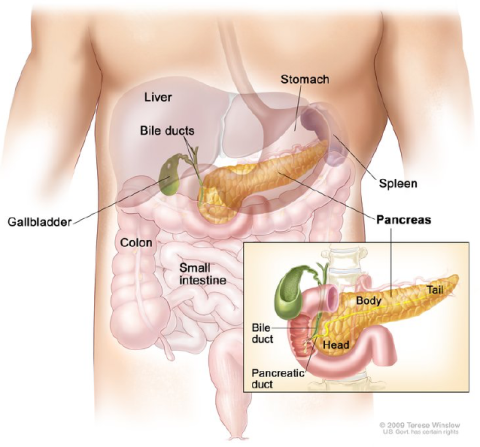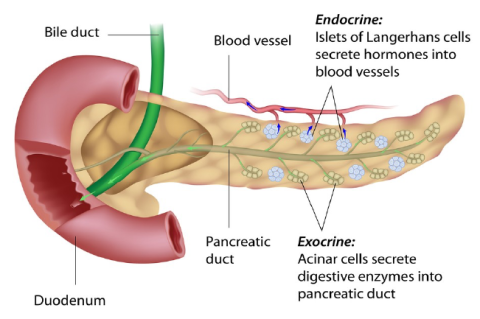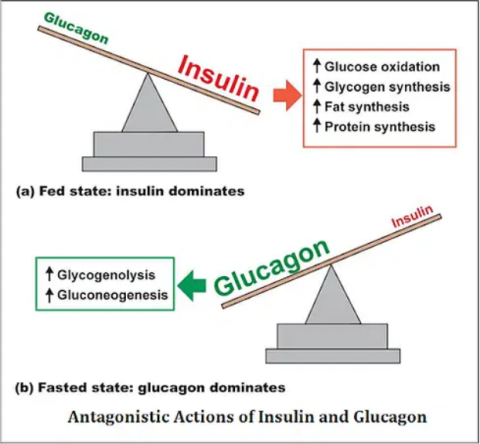The Impressive Pancreas
Routine conversations among individuals often include health issues such as weight loss, smoking, alcohol, and blood pressure to name a few. Seldom do we discuss the function or importance of the human pancreas. Most individuals are familiar with organs such as heart, lung, kidneys, brain, etc., but the pancreas is a mystery to many. Disorders of the pancreas can give rise to well-known conditions such as diabetes mellitus, malnutrition, severe inflammation of the abdomen, and life-threatening malignancies. For example, failure of the pancreas to secrete sufficient insulin into the blood stream causes diabetes mellitus. Diabetes affects approximately 14% of the population in the USA, with the average expense annually per patient approaching $10,000. 1 2
Insufficient pancreatic function can also lead to profound weight loss. If digestive enzymes secreted by the pancreas are insufficient, daily food intake cannot be absorbed by the intestine. Weight loss and failure to thrive subsequently emerge. Inflammation of the pancreas (pancreatitis) is a common entity seen in emergency rooms across the country. Gallstone disease or alcohol intake are typically responsible for most episodes of pancreatic inflammation. In 2020 (in the USA) 46,700 people died of pancreatic malignancy, which is the third leading cause of cancer deaths behind lung cancer and colon cancer. 3
The mortality rate for pancreatic cancer is high because the malignancy is aggressive and difficult to diagnose early. A well-functioning pancreas is important to each of us. This article will explore the incredible activity of the pancreas that keeps us alive and healthy on a daily basis.
The pancreas is situated high in the upper abdomen behind the stomach, adjacent to the spine. It is elongated, somewhat like a fish, with head, body, and tail regions (Fig. 1). The head region is intimate with the duodenum (part of the intestines), and there is an extensive network of major blood vessels that surround it. The pancreas itself is not easily identified visually in humans as its coloring is very close to the surrounding supporting tissues, and it is soft and easily fractured or disrupted. Surgical exposure of the pancreas must be carefully approached to avoid bleeding or injury to the organ. Because of the challenges of pancreatic surgery, management of surgical pancreatic disease is itself a subspecialty in many American hospitals.
The pancreas has a triple function which includes secretion of enzymatic proteins into the intestine, secretion of alkaline fluid into the intestine, and secretion of regulatory hormones into the blood stream. Each of these is important to maintain a well-functioning healthy system. Each of these functions will be examined separately.
Below is a list of the enzymes secreted by the pancreas directly into the intestine.
Enzymes secreted by the pancreas
- Proteolytic:
- trypsin,
- chymotrypsin,
- carboxypeptidase,
- elastase
- Lipolytic:
- lipase,
- phospholipase,
- esterase
- Glycolytic:
- lactase,
- amylase
- Nucleolytic:
- ribonuclease,
- deoxyribonuclease
Pancreatic secretions promote the digestion of proteins, fats, sugars, and nucleic acids. The digestion of food by the pancreatic enzymes results in simpler molecules which can be absorbed by the intestine. Several of the enzymes are secreted in a precursor form which are subsequently activated in the intestine itself. This sequence prevents the pancreas from being digested by its own enzymes. If there is insufficient secretion of pancreatic enzymes (for example by obstruction, cancer, infection, etc.), the individual will not be able to digest food and will become progressively malnourished. Modern medicine fortunately has developed oral supplements that can replace these important enzymes and reverse the weight loss associated with pancreatic enzyme insufficiency. However, the normal pancreatic secretion of enzymes is essential for us to digest and absorb our daily food intake.
The pancreas also is responsible for secretion of alkaline fluid into a section of the intestine (duodenum). The stomach is a continuous source of acid fluid with pH as low as 1.5, which is emptied directly into the duodenum. (Battery acid for example is about pH 0.8.) The acid output would cause ulcers in the duodenum if left unopposed. The pancreas typically secretes one liter of alkaline fluid with pH up to 9 to counteract the stomach’s acid output and promote the normal activity of digestion in the remaining intestine. The pancreas secretes the exact amount of alkaline fluid to completely counteract the acid. If there is insufficient secretion by the pancreas, the acid output of the stomach causes ulcers to develop. Oral antacids offer another way to counteract stomach acidity and are used frequently for duodenal ulcer disease.
The pancreas not only secretes enzymes and alkaline fluid into the intestine, but it also secretes hormones directly into the blood stream. The pancreas has tiny islands of cells distributed throughout the gland called islets of Langerhans. They are distributed randomly throughout the pancreas somewhat like raisins in raisin bread. The tiny islets can be easily identified under microscopic visualization of pancreatic tissue (Fig. 2). 4
The islets of Langerhans secrete several hormones into the blood, including insulin, amylin, somatostatin, pancreatic polypeptide, and glucagon. 5 Insulin and glucagon are the more important hormones and are involved in the regulation of glucose (sugar) levels in the blood stream. Insulin serves to lower the blood glucose level, and glucagon works to elevate it. Insulin works by facilitating the transportation of glucose from the blood stream to the inside of the cells of the body. The insulin protein binds to specific receptors on the cell wall which promotes the uptake of glucose into the cell. The blood glucose levels fall in response to insulin. Glucagon functions by stimulating the release of glucose stored in the liver into the blood stream. The blood glucose levels rise in response to glucagon. As the two hormones interact, blood sugar is maintained at a healthy level. Since glucose is the main fuel source of the cells in our body, close regulation of this level is important. When we eat a large meal, insulin is released.
When we are fasting, glucagon comes into play (Fig.3). 6 Both are required to maintain good health.
As we undertake our daily activities, we typically do not give concern whether our pancreas is secreting sufficient enzymes or if there is enough alkaline secretion to offset the acid output of the stomach. The system runs autonomously and accurately. True, some individuals with diabetes mellitus do have concern about their insulin levels and monitor their blood sugar level to guide insulin administration. But in a good health situation, the pancreas senses the demands of our digestion and glucose metabolism and reacts appropriately.
The amazing function of the pancreas gives rise to several questions: how does both the construction and control for such a complicated system arise? How do the pancreatic glands know when and how much to secrete into the intestine? How do the islets of Langerhans know when and in what quantity to secrete hormones that attach to receptors on each cell throughout the body to coordinate the desired effects? All of this is programmed in a predetermined fashion to keep us healthy! How did all this happen? Science does not have an answer for these questions, but consider the words of Job about the skills of God:
He performs wonders that cannot be fathomed, miracles that cannot be counted. (Job 9:10) 7
King David was well acquainted with the mysteries of the human body when he penned:
For you created my inmost being; you knit me together in my mother’s womb.
I praise you because I am fearfully and wonderfully made; your works are wonderful, I know that full well. (Psalm 139:13–14)
God himself comments on the questions that confront us:
“I am the Lord, the God of all mankind. Is anything too hard for me?” (Jeremiah 32:27)
In more basic terms, the construction of a complicated engine that performs complicated tasks mandates the design and organizational skills of an intelligent engineer. In our situation, the engineer of our complicated and fully functioning body is the Lord God Himself.
- 1American Diabetes Association (2018) The cost of diabetes: Economic costs of diabetes in the U.S. in 2017. Diabetes Care 41(5):917–928. https://diabetes.org/about-us/statistics/cost-diabetes Accessed 2023 Sep 11
- 2Johns Hopkins Bloomberg School of Public Health (2018 Aug 16) Study finds undiagnosed diabetes in U.S. less than half of current estimates. https://publichealth.jhu.edu/2022/study-finds-undiagnosed-diabetes-in-us-less-than-half-of-current-estimates Accessed 2023 Sep 12
- 3Centers for Disease Control and Prevention (2022) An update on cancer deaths in the United States. https://www.cdc.gov/cancer/dcpc/research/update-on-cancer-deaths/ Last updated 2022 Feb 28
- 4Dinsmoor RS (2016 Feb 19) Beta cells. Diabetes Self-Management https://www.diabetesselfmanagement.com/diabetes-resources/definitions/beta-cells/Accessed 2023 Sep 12
- 5Karpińska M, Czauderna M (2022) Pancreas—Its functions, disorders, and physiological impact on the mammals’ organism. Front Physiol 13: 807632 https://www.ncbi.nlm.nih.gov/pmc/articles/PMC9005876/ Accessed 2023 Sep 12
- 6King Saud University (2023) Diabetes. https://ksumsc.com/download_center/Archive\/2nd/434/3-Endocrine%20Block/Teams/Pathology/4%2C5-DiabetesType%201%262.pdf Accessed 2023 Sep 12
- 7All Scriptures cited are taken from: Holy Bible, New International Version®, NIV® Copyright ©1973, 1978, 1984, 2011 by Biblica, Inc.®


